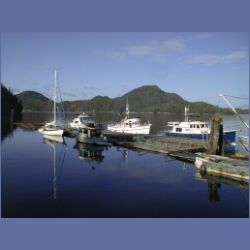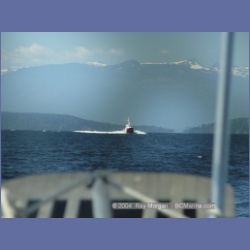| Trawlers: |
| Having consulted with a number of fellow
travelers, both power and sail, I will open myself to criticism and
state that the best type of vessel for conditions on the North Coast is
a single screw, displacement, Trawler style boat. This type of
vessel has the advantages of range, foul (rainy) weather comfort and
good seakeeping that suite the environment.
As the summer here is often cool and
rainy, we like to spend the sunny days ashore and rain for a trawler is
good 'traveling weather". The single screw, full keel trawler
design is less susceptible to damage from floating debris than a twin
screw vessel and one could conjecture, has half the chance of having
engine trouble.
|
 |
|
|
Sailboats:
|
| The standard sloop or ketch rigged,
inboard diesel sailboat has the advantage of being significantly more
capable in dealing with really rough seas and has built-in redundancy in
propulsion. The odd thing is that one rarely sees sailboats
actually sailing on the north coast even though many are significantly
underpowered. I have never found a good reason for it but that is the
way it is.
The most significant disadvantage of the
standard sailboat here is that in this often rainy climate, one must don
the raingear and stand out in the weather to steer. The ideal compromise
is a large, closed cockpit motorsailer.
Sailors N.B.: If you have one of those
silly folding-pinwheel racing propellers, before you venture north
replace it with a proper three blade prop matched to your engine and
hull speed. If your only engine is an outboard motor kicker; Well,
lets just say you will have quite an adventure on the north coast. |
 |
|
| Plague Ships: |
| Giant speedboats that churn up huge
wakes while racing to the next gas pump and run their gensets day and
night to power the TV, the tunes and the electric weenie roaster: |
| No (public) comment. |
|
 |
|
Sailing
Vessel 'Joshua' in Columbia Cove, Brooks Peninsula. A replica of 'Spray'
in which Joshua Slocum made the first solo circumnavigation of the
world. |
|
| Fuel (range) and
fresh water capacity: |
| Shelyann burns less
than two of her 200 US gallons of fuel per hour at 7.5 knots giving an
absolute range in the neighborhood of 700 miles. We carry about 60
gallons of fresh water and sometimes wish we had more. The water from many
sources along the coast is discolored with cedar tannin but we have taken
no extraordinary precautions about using it and have suffered no ill
effects.
Klemtu has fresh, clear, lake water at the
fuel dock. For the best tasting water on the coast,
Idle the bowsprit up to one of the rivulets streaming thousands of feet
down the cliff faces in Kynoch Inlet and fill up a cold pitcher or two.
There are no beaver-fever beavers up there!
|
|
| |
| |
| We've never sat down and
figured out the minimum range required to make the trip, but fuel can be
had every 150 miles or so along the inside passage, although generally at
high prices in isolated places. Best fuel prices are at Port McNeil, Port
Hardy, Prince Rupert, Ketchikan and Juneau. At Ketchikan you can
give the engine a treat and get #1 Diesel at the pumps for a few cents
more.
We haven't had any significant problems
with dirty fuel from any of the suppliers on the north coast but it is a
possibility. One year I thought we had an injector problem, as the
Volvo's exhaust started smoking quite badly after fueling at one
out-of-the-way place. |
|
|
| |
| |
| The smoke disappeared soon
after filling the near empty tanks from a different source. The most
important factor in avoiding fuel and injector problems is, of course,
proper filtering. Shelyann's fuel is double filtered through an external
Racor filter and the Volvo filter on the fuel pump. |
|
|